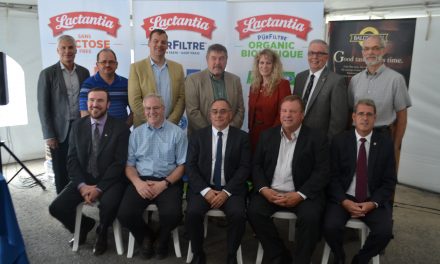by AJ Al-Rajab, PhD
AgriNews Staff Writer
CALIFORNIA – Once again, the famous herbicide Roundup drew the attention of everybody earlier in August when a Californian jury in the U.S. ordered the fabricant Monsanto to pay $289-million to a landscaper who claimed his terminal cancer was caused by using this weed-killer for years. Monsanto said they would appeal. However, glyphosate (the active ingredient of Roundup) is still valid to use in Canada in agriculture and non-agricultural land management but it was banned with other pesticides for cosmetic purposes (home lawns and gardens) in Ontario and other provinces.
In Canada, glyphosate is the most widely used herbicide in agriculture and sprayed on crops such as wheat, canola, potatoes, soybeans and corn. Also, glyphosate is widely used in non-crop and industrial lands. In April 2017, Health Canada’s Pest Management Regulatory Agency (PMRA) re-evaluated the human health risk of glyphosate (active ingredient and formulated products) from food, drinking water and occupational exposure (Re-evaluation decision RVD2017-01, Glyphosate). PMRA announced that: 1) glyphosate is unlikely to pose a human cancer risk; 2) there is no risk to human health from food and drinking water exposure associated with glyphosate; 3) the potential risks to human health and the environment from pesticides containing glyphosate are acceptable, if used as directed in the updated labels.
By April 2019, manufacturers will be required to update the commercial and agricultural class products containing glyphosate to include statements such as: 1) the re-entry interval into the sprayed agricultural areas after application is restricted to 12 hours; 2) the product is to be applied only when the potential to spread to areas of human activity, such as houses, cottages, schools and recreational areas, is minimal by considering the wind speed and direction, temperature and the application equipment; and 3) instructions for buffer zones to protect areas beyond those targeted as well as the aquatic habitats.
What is glyphosate?
Glyphosate is a systematic, broad-spectrum, non-selective, organophosphorus herbicide. It is the most used active ingredient worldwide in agricultural, silvicultural and industrial zones. This herbicide was discovered by Monsanto in 1970 and was introduced to the market in 1974 under the brand name “Roundup”. Glyphosate products are commercialized as solutions, tablets or pastes and can be applied using ground, aerial equipment or even stem injection treatment. The application dose varies depending on the treated site and the weed species from 0.25 to 4.32 kg active ingredient per hectare.
Why using glyphosate?
Glyphosate is an important herbicide for Canadian agriculture as stated by PMRA in April 2017. The unique characteristics of glyphosate of broad weed control spectrum and wide application window from pre-seeding to post-harvest, provide a flexible and effective weed management program in several major crops grown in Canada, i.e. wheat, corn, soybeans, canola, and apple orchards. Also, it is used to control many invasive weed species and toxic plants. However, the use of glyphosate became essential for weed control after the introduction of glyphosate tolerant crops (GTCs) such as corn, soybeans, canola, cotton and sugar beet. In addition to its efficiency and flexibility of usage, its availability in the market at affordable prices made glyphosate the most popular herbicide for the agricultural producers.
Mode of action, how does glyphosate kill weeds?
After application of glyphosate on weeds, it is absorbed through foliage and readily transported inside the plant to the growing leaves and roots because of its systemic activity. The amino acids are the “building blocks” for proteins for plant growth and the development of a plant. Glyphosate acts as aromatic amino acid inhibitor upon a specific enzyme (EPSPS) to prevent the production of amino acids, vitamins and many secondary plant metabolites which stop the growth of the plant within hours of application, leaves then turn yellow after a few days. However, glyphosate is only effective when applied on actively growing plants, it is no longer active after reaching the soil and cannot prevent seeds from germinating.
Glyphosate tolerant crops (GTCs)
Based on the understanding of the mode of action of glyphosate, the crops can be modified using genetic engineering in several ways to be GTCs such as incorporating a soil bacterium gene obtained from agrobacterium sp. into the plant genome that produces a glyphosate tolerant form of the enzyme EPSPS, or by incorporating a different soil bacterium gene that produces a glyphosate degrading enzyme.
The glyphosate tolerant soybean was introduced by Monsanto in 1996, then the glyphosate-tolerant corn in 1998, while glyphosate tolerant canola was introduced commercially in Canada earlier in 1995. The combination of GTCs (also known as Roundup Ready) and glyphosate is an important agricultural practice in Canada. The introduction of GTCs allowed the farmers to apply glyphosate to control weeds in the fields without damaging their crops.
Environmental behaviour of glyphosate
After the application of glyphosate for weed control, a part of herbicide reaches the target plants and another part settles on the soil. Therefore, a part of glyphosate will be absorbed by the soil constituent and another part will still be available in the soil solution. The available residues of glyphosate in soil solution will be either mineralized or transferred to groundwater through the soil. The physicochemical properties of the soil, its biological activity and other chemical and biochemical reactions lead to the degradation of the herbicide.
Degradation of glyphosate is relatively rapid in the soil, which could be a limiting factor to contaminate the solution of soil and groundwater by glyphosate. On the other hand, this rapid degradation could increase the risk of pollution by its metabolites aminomethylphosphonic acid AMPA and sarcosine. Only the complete mineralization of a pesticide could eliminate its risk for a potential environmental pollution. The strong absorption of glyphosate into soil and the rapid formation of non-extractable residues increase the stabilization of the compound in the soil and decrease the short-term water pollution. These residues could be remobilized in the long-term and could reach the groundwater at low concentrations. The half-life (time taken to fall to half of the original value) of glyphosate varies from six to 10 weeks in water and from one to nine weeks in soil.
How the residues of glyphosate are measured?
Extraction and determination of glyphosate residues in different matrix (water, soil, plant and urine, etc) is an analytical challenge because of its high solubility (about 10.5 g/L in water) and its other physicochemical properties. However, different analytical techniques require highly trained staff and specialized laboratories are used to determine the residues of glyphosate such as high performance liquid chromatography HPLC, high performance liquid chromatography mass spectrometry HPLC-MS/MS, and enzyme linked immunosorbent assay ELISA. However, some specialized research labs use the labelled compound with the radioactive isotope of carbon (14C-glyphosate) in order to study the behaviour of the herbicide in the environment and plants. To this end, some special instruments such as liquid scintillation counter LSC and oxidizer are required along with the standard certifications.
In Canada, the Canadian Food Inspection Agency is responsible for monitoring the Canadian food supply for pesticide residues with respect to the maximum residue limits (MRL) specified by Health Canada. Therefore, the Canadian food supply would not include products that contain higher level of pesticides than the permitted MRLs.
How to protect yourself when spraying glyphosate?
The label is the most important guideline to apply any pesticide. Read the product’s label carefully and follow the instructions. The label also contains the application rates, how to mix the product, the safety instructions and all important information related to the product. However, the appropriate personal protective equipment such as long pants, long sleeved shirts, goggles and chemical-resistant gloves should be enough to minimize the exposure to glyphosate and no additional protective clothing is required.
In conclusion, based on the re-evaluation decision published by Health Canada PMRA in April 2017 and the evidences from scientific reports and studies, the herbicide glyphosate is not expected to pose human health risks if used as mentioned in the label and it is still valid to use in agricultural, non-crop and industrial zones.












